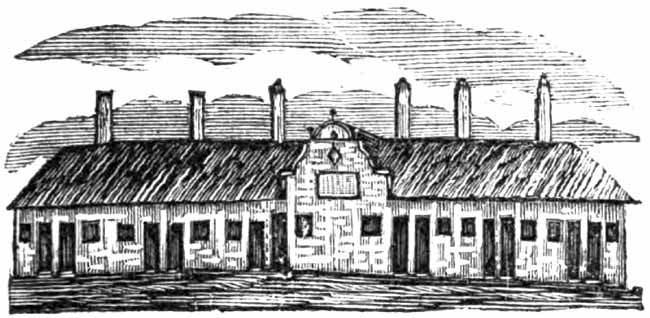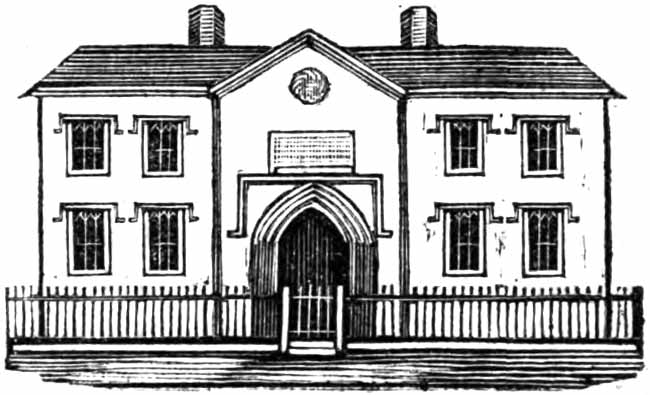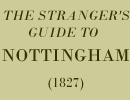< Previous | Contents | Next >
After reviewing this place, we turn to the right, into Warser-gate, where, a few doors down the street, on the south side, are the
WARSER-GATE HOSPITALS.
Six tenements for six poor people of the parish of St. Mary. There have been four other rooms erected in the yard very recently, and these are also in the gift of the parish officers of St. Mary's. The first six rooms have a weekly endowment, but the other four have little or nothing. Going down Warser-gate, we come to the north end of Mary-gate, a little way down which, on the right-hand or west side, is
MARY-GATE CHAPEL.
Erected in 1801, by a sect of Independents, known by the name of Inghamites, who profess sentiments nearly allied to the Sabellians. The building is forty-one feet nine inches by thirty-six feet, and has a gallery therein. The elders are Mr. I. Bailey and Mr. J. Churchill, and service is performed every Sunday, at half-past ten and two. We now go back into Warser-gate, and continuing our course, turn to the right into Stoney-street, where, on the east side, is a range of twelve poor houses, known by the name of

HANDLEY'S HOSPITAL,
where twelve poor persons reside, and have sixteen shillings and eightpence per quarter paid them by the agent of John Longden Sherwin, Esq. of Bramcote, who it is understood, holds ample estates for their repair. Upon a stone in the centre of the building, is an inscription which is nearly illegible, but of which the following is a copy :—
Henry Handley, Esq; whose Body is interred in the Church of Bramcote in the County of Nottingham, caused this Alms-House to be erected for 12 poor People, and did give one hundred Pounds yearly, forth of his ancient Inheritance, Lands at and near Bramcote aforesaid, for pious and charitable Uses, to continue for ever. Namely XLl. for the Maintenance of the said 12 poor People; XXl. for a Weekly Lecture in this Town; XXl. for a Preaching and residing Minister at Bramcote; Vl. for the Poor of Bramcote ; Vl. for the Poor at Wilford; XXs. to the Poor of Beeston ; XXs. to the Poor of Chilwell: XXs. to the Poor of Attenborow and Toton ; XXs. to the Poor of Stapleford; XXs. to the Poor of Trowell; XXs. to the Poor of Woollaton; and IVl. to the Poor Prisoners in the Gaols for the County of Nottingham yearly for ever, and one third Bell to the aforesaid Church of Bramcote.— This pious, most charitable, and at this Time most seasonable Donation, as it deservedly perpetuates his Memory to be honoured by all Posterity, so it gives a most worthy Example for Imitation. He died the 10th Day of June 1650.
Exactly opposite this hospital, is the end of a noble row of buildings, known by the name of King's-place, and at the far end is the
ROMAN CATHOLIC CHAPEL,
which is by no means a commodious place, and is not large enough for the congregation that usually attend there; they are therefore erectinga more convenient place, in George-street The priest is the Rev. Wm. Willson, and the services are at ten and three, every Sabbath. On the opposite side of Stoney-street, is Barker-gate, near the top of which, on the left or north side, is
SALEM CHAPEL.
Another Independent or Calvanist chapel, under the pastoral care of the Rev. J. Jones. This neat, though small place of worship, was erected in 1815, by the Rev. W. Batcher, and a number of his followers, who originally separated from St James's church.—Mr. Butcher preached for some time in various parts of the town, until at length the present edifice was built, where divine service is performed three times on the Sabbath-day and every Wednesday evening at seven. Immediately adjoining this chapel, is St. Mary's burying ground, No. 2, or as it used to be called, the new burying ground, and on the opposite side of the street, a little lower down is St. Mary's burying ground, No. 1, known as the old burying ground, but both these being full, another was purchased some years ago; but of this, more hereafter. We must now retrace our steps to the top of the street, where at the north-west corner, stands the
FREE GRAMMAR SCHOOL,
founded, as a tablet in the wall fronting Stoney-street, will tell you, by Agnes Mellers, in the year 1513. This is an ancient and excellent institution, where nearly 100 boys are gratuitously instructed in Latin, Greek, English, and the classics; and writing and arithmetic are added, by the small payment of ten shillings a-year. There are ample endowments in the hands of the Corporation, for the support of the institution. The Rev. Robert Wood, D. D., the head master, resides in a good house, close to the school; the usher is the Rev. S. Mc. Lund; and Mr. J. P. Hemm occupies the situation of writing master. On a white tablet, fixed in the building, is the following inscription:— This School was founded by Agnes Mellers, A.D. MDXIII. Repaired MDCLXXXIX, and MDCCXCII. We now proceed along Stoney-street, where a turn to the left, known by the name of Plumptre-place, leads through an iron gate, to the
GENERAL BAPTIST CHAPEL,
erected in 1799, and measuring forty-seven feet nine inches by forty-seven feet eight inches, being very near a square. The pastor is the Rev. Wm. Pickering; the Sabbath services are at halfpast ten, halfpast two, and six; and there is service also on Tuesday evening at seven. A very commodious burying ground, and extensive school rooms, immediately adjoin the chapel. Returning into Stoney-street, on the opposite side, is
PLUMPTRE HOUSE,
a very superior building, erected many years back, as the mansion for the ancient house of Plumptre, but which they have deserted for many years, and it is now the residence of Wm. Wilson, Esq. one of the Aldermen of the town. Again crossing into Plumptre-street, we find on our left hand
PROVIDENCE CHAPEL,
a small building occupied by the followers of the celebrated Huntington, where there is service at halfpast ten and halfpast six on the Sabbath, and at seven on Wednesday evenings. By going to the bottom of this street, we find our way into Bellar-gate, and turning to the right, on the east side is Dean-street, which leads to Mary's new burying-ground, before adverted to, which was consecrated by the Archbishop of York, and devoted to its present purpose in 1817. Pursuing our way down Bellar-gate, we get into Hollow-stone, and thence into Plumptre-square, where stands

PLUMPTRE HOSPITAL,
unquestionably the most ancient charitable institution in this town or neighbourhood. It was originally founded by John de Plumptre, in 1392, in the reign of King Richard II. (435 years since). In 1650 and 1751, it received considerable repairs, but being in a very dilapidated state, John Plumptre, Esq. of Fredville,, in the county of Kent, a descendant of the founder, obtained an act of Parliament, in the third year of his present Majesty's reign, (1823) by which some land in the town, belonging to this hospital, was disposed of, and an entire new building was erected on the site of the old one. Thirteen aged widows are here provided with a comfortable asylum at the close of life; they have about six shillings a week each, and a ton of poals, a gown, &c. every year. The present steward for the hospital, is Henry Percy, Esq. and its management reflects credit upon all that are concerned in it.—Besides those within the walls, thirty out-pensioners receive ten pounds each per year from the proceeds of this munificent and useful endowment. The present building, which was erected after a design drawn by Edward Staveley, Esq, architect, is quite an ornament to that part of the town. and the apartments within, are light, airy, and comfortable. It is substantially built of brick, in the ancient style, and covered with stucco, in imitation of stone, the whole being surrounded by a neat iron railing. The inscription in front of the building, on a black tablet of stone, is as follows:—
Plumptre Hospital :
Founded and endowed, for the support of a Master,
a Priest, and thirteen Poor Widows;
By John de Plumptre, A. D. 1390.
Repaired by Huntingdon Plumptre Esq. A. D. 1650,
By John Plumptre, Esq. A. D. 1751,
By John Plumptre, Esq. his Son, A. D. 1753,
The first stone of the present hospital was laid on the first day of August, A. D. 1823: by The Rev. Charles Thomas Plumptre, Rector of Claypole, Lincolnshire, on behalf of his Father. John Plumptre, of Fredville, in the County of Kent, Esq. the Master or Guardian of the said Hospital, and a Decendant of the Founder.
Leaving Plumptre hospital, and going on the high road to the south, which is the great London road, we pass over the Leen and then over the canal, by which there is a communication with all parts of the kingdom, and by means of which the town is supplied with coal of a very superior quality, from pits in the immediate neighbourhood. We have now in view, on each side of the road, a large track of low meadow land, which is subject to floods, whenever the Trent overflows its banks. That on the right or west side, is known as the Nottingham Meadows, containing 283 acres, owned by many proprietors, but commonable to the burgesses at large, from the 6th of July to the 13th of August, and from the 3d of October to old Candlemas day. The land on the east or left side, is termed the East-croft, containing fifty-one acres, and is also commonable land from the 19th of September to old Martinmas-day. By travelling onwards, we come to the seven arch bridge, the use of which is solely to carry off the water under the road, at periods when the meadows are flooded. This bridge is built of stone, and is 120 yards in length. It was erected in 1796. Next are the Nine Culverts, built in 1809, to carry off the flood water, which sometimes rises to an amazing height, and next is a broad arch over what is called the Chainey Pool, which derived its name from a bridge supported by chains, being formerly over it.—Travelling onwards, throngh the two toll-gates, the first of which belongs to the commissioners of the road, and the second to the Corporation, we come to the ancient
TRENT BRIDGE.
The river Trent, which is the third in England, both in size and beauty, being only excelled by the Thames and the Severn, rises in Staffordshire, in which county it is joined by the Tame; it receives the Dove and the Derwent in Derbyshire, and the Soar in Leicestershire; it then visits Nottingham, and passing through Newark and Gainsborough, falls into the Humber, about twenty miles below the latter place. The bridge over this river, was built in the year 1683, the former one, erected by King Edward the elder, having been destroyed by ice. In 1806 it was considerably enlarged and repaired, and in 1826, was again repaired, and so altered, that whereas, before the water only ran through three arches out of seventeen (except in time of flood,) it now passes through six of the arches. A few yards on the other side of the bridge is the extremity of the limits of the town, we will therefore go no further, but retrace our steps, and in so doing, we shall have time to admire a part of the picturesque village of Snenton, over the East-croft, on the right hand, with its newly repaired church, and to the left may be seen the park, and the castle erected on its precipitous rock, which is 133 feet above the level of the meadows. Crossing the bridges again, we go onward till we arrive in front of Plumptre hospital, which leaving to the left, we turn down Butcher-street, which leads us to the
GAS WORKS,
an extensive establishment, for lighting the town with gas. The act for the formation of the company was passed on the 8th of May, 1818, and the gas was first lighted in this town, on the 13th of April, in the following year. It is generally allowed that the gas is of a superior description, the rates are moderate, and the establishment flourishing, but it is to be regretted that the street lights are not more generally diffused throughout the town. The clerk of the works is Mr. Reuben Young.— Immediately adjoining the gas work, is the extensive establishment of Messrs. Cox, Poyser, and Co. for the manufacture of white lead, and fronting these is New-street, leading into Fisher-gate, where we find at the corner of Carter-gate, another elemosynary institution, called
WILLOUGHBY'S HOSPITAL,
which was erected and endowed by property left by the will of Thomas Willoughby, in the year 1525.—There are now nineteen tenements, the inhabitants of which receive a trivial allowance, but the estate, which is vested in the churchwardens and overseers of St. Mary's, is very ample, and when some of the leases fall in, in 1830 and 1831, no doubt the income of the objects of this charity will be increased.
